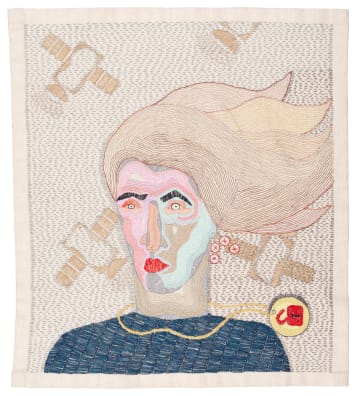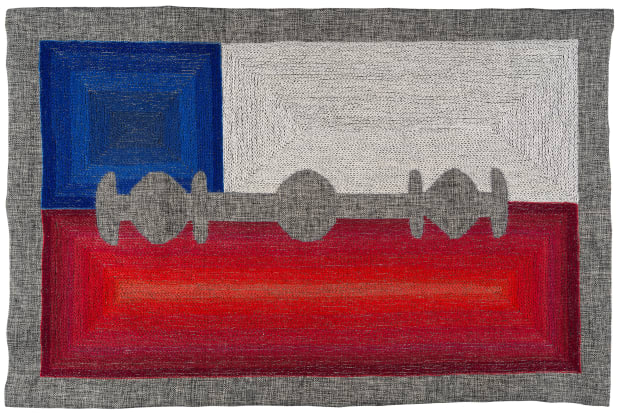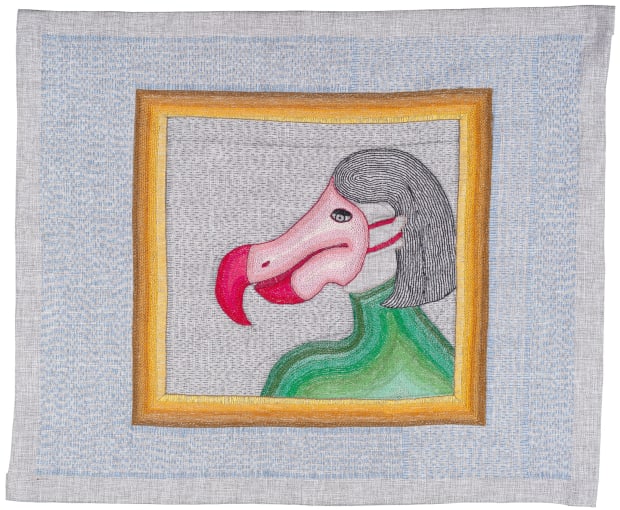Isabel Croxatto Galería is pleased to present Ad Hominem¸ a solo exhibition by the prominent textile artist Paloma Castillo. The show, curated by artist and academic Leonardo Casas, is composed of a series of 23 hand embroideries, created between late 2020 and mid-2021, in which the artist continues to explore social issues that concern Chile and the world. Through meticulous work and vibrant colors, Castillo embraces personal experiences and everyday life, as well as mythological tales and the representation of exuberant characters.
-

Ad Hominem, 2021. Hand embroidery with cotton threads on linen, 43 x 65,5 cm
-
Sublime Stitches
Ad Hominem by Paloma CastilloIn The Subversive Stitch (1984), Rozsika Parker mentions the alteration of imposed codes of conduct through the incorporation of labour in the creation of embroidered flags and emblems: "In hands of the suffragettes, embroidering was employed to transform the place and role of art, rather bring about a change in reality and the status of women".
Ad Hominem is the name of Paloma Castillo's latest exhibition. The term "ad hominem" refers to a fallacious argument directed against a person based on the external attributes they manifest; an ad hominem argument points to the form, not the content. Fallacious ideas and discursive constructions saturate our reality. Every day we hear, read and observe in the public sphere a display of arguments, attacks, public discrediting and partial truths exalting the apparent, the irrelevant. Paloma Castillo places her point of view in this vertiginous deformed reality in which she has had to exist to articulate her artistic work.
Paloma Castillo sets out the process of constructing her imagery in awareness and attention to her present. Ad Hominem consists of 23 textile artworks. In the visual universe produced by the artist, embroidery is developed as a cultural practice that involves iconography, style and a social purpose. There is a transformation of materials that yields a meaning aimed at exploring our current context. The artist works based on a personal archive of images compiled from diverse sources (pop culture, journalistic photos, emblematic figures), which play a referential role as well as a register of her interests.
The conceptual strength of Paloma's embroidered images is rooted in the creation of connections or antagonistic relationships between ideas and images through the manipulation and staging of certain literary figures, mainly paradox, contradiction and even antinomy. The embroidered pieces become expressions of significant experiences that have a historical, cultural and social context. In its entirety, Paloma Castillo's work takes us back to the always fascinating and dynamic rhetoric of pop.
The iconic and perfect Campbell's Soup Can is modified in the piece War (2021), where it's converted into a waste product that contains the rebellious fire of urban violence. Paloma Castillo's works allow us to approach our reality on different levels, both as a plastic object and as an ideological reflection. In War, the tension of the gaze focuses on the translation of fire and the soup can that Castillo shapes through embroidery. The usage of different coloured threads and optical combinations give way to a piece with light and movement of its own; moreover, the composition of the figures evokes protest emblems which, at first sight, express the essence of her idea. Nowadays, the concept of "war" has transmuted into a hip term whose enunciation and discursive use seeks to precipitate a moment of drama and fear in public opinion. Paradoxically, the idea of "war" has become part of everyday life, normalised to the point of being sold in conflict zones as a tourist attraction. In another work, Ad Hominem (2021), Castillo has embroidered a Chilean flag that is itself a razor blade. The grey in the background reinforces the effect of reversibility to the point of projecting it into a threatening, contentious gesture. Through stitches on fabrics, Paloma Castillo gives shape to another fabric: the flag. It acts as a conceptual image of the social crisis. Such a disturbing and seductive composition can only give rise to questions. Unable to maintain its protective aura, is the Chilean flag transformed into a razor blade? Or is it, perhaps, a razor blade in which we see our flag reflected, on the verge of a fatal outcome that will involve rags?
Within the tradition of embroidery, the principle of capturing fragments, events and significant figures of collective interest through the stitch of thread can be traced back to the emergence of the suffragette, women's, workers' and teachers' movements in England in the early 20th century. Amid strikes and street protests, women took over the public space, marching and demanding recognition of their rights. The making of the "marching banners" involves both collective work and the conscious use of diverse crafts, artistic and literary techniques. The embroidery of texts and figures on fabrics to be later applied to these flags opened up the possibilities of the medium while also promoting the birth of an autonomous graphic language. Hammers, mills, chains, fires, texts, and organic forms such as flowers, animals and embroidered plants became a visual lexicon associated with a social struggle. In The Subversive Stitch (1984), Rozsika Parker mentions the alteration of imposed codes of conduct through the incorporation of labour in the creation of embroidered flags and emblems: "In hands of the suffragettes, embroidering was employed to transform the place and role of art, rather bring about a change in reality and the status of women".
Paloma Castillo does not use a stretcher frame for producing her artworks, giving her pieces freedom and spontaneity. Working with the canvas in its "wild" state implies leaving aside the pattern and organising a unique and unrepeatable working logic within the piece. The liberation of the stretcher asserts an expansion of the possibilities of language, both thematically and technically. From a historical perspective, this abandonment represented an important milestone in the dismantling of cultural and social impositions on the conditions of production and reception: a moment is reached where the culturally imposed statutes of embroidery, the celebrated order and symmetry of materials, simply begin to dissolve.
"I paint things that I use every day and that I never really stopped to think about."
-Andy WarholOur daily lives involve the constant use of electronic devices, utensils and objects of different kinds. In Paloma Castillo's work, the object acts as a catalyst for the reality that the artist depicts, interprets, and recognises as a part of it: irons, telephones, hot-water bottles, rolling pins, among other figures, are integrated into an intricate iconographic universe throughout her work. Paloma reveals how our domestic and personal life is also a product of the institutions and ideologies that govern us through small nods and details found within her pieces.
In Trampa I, Trampa II and Trampa III (2021), Castillo constructs different scenes in which a variety of traps seem to lie in wait for us, playing with our curiosity. In the process of dematerialisation of the real object that arises through embroidery, both the design and the purpose of these figures is completely altered. The objects are condensed, rethought in their initial function, to be recomposed through the embroidered stitches on the fabric. What was exact now is soft. Embroidery casts an effect of material sinuosity that seems to project the rigidity of the trap into a world of ideas only accessible from the alteration of perception.
On the other side of Paloma Castillo's visual world, we find an iconographic universe composed of figures with human attributes and the animal kingdom. From their relationship with the world, as archetypal figures in myths of transformation, these creatures exercise a symbolic function that links them to human becoming. In mythology, animals are represented as agents of change, advising us about the present, warning us of the future and exchanging characteristics with humans. In the piece Didus Ineptus (2021), Paloma presents a person wearing a dodo bird mask. The title is a direct reference to Schopenhauer's text On the Will in Nature (1836), in which he catalogues this bird as "didus ineptus", pointing out that its extinction was due to the bird's inability to develop any natural form of self-protection. For the once greatest creature, its own unawareness of its reality or physiognomy was, in the end, the cause of its extermination.
In the language of embroidery, portraiture fulfils a narrative function intersected by historical, aesthetic and emotional interests. From the effigies of the great women of the struggle against oppression, rubricated on the banners of demonstrators, to the pop stars embroidered on handkerchiefs by the American artist Jenny Hart, the embroidered portrait evokes and expands the scope of the individuality of the figures it represents. El Joven Calígula and Agripina (both 2021) are part of a gallery of portraits where the artist explores the overlaps between classical myths and history and the figures shown to us in the secular sphere. Caligula, well-known for the excess and decadence of his empire, but who nevertheless appeared publicly dressed as Hercules or Venus, and his mother Agrippina, whom the oracle reveals that her own son will assassinate her, initiate a myriad of conspiracies and intrigues whose outcome is death. Political tension, role reversal, celebrity scandal. The reality far exceeds fiction, and the stories of scandalous and amoral figures become our new cautionary tales.
Placed in the current arena, embroidery within the world created by Paloma Castillo polarises and collapses theoretical positions around the paradigms of art-making today. "To 'elevate' embroidery simply to a status of 'Art' is to affirm the hierarchical categorisations that brought it into a space of inequality in the first place, obscuring the profound differences and inequalities that have emerged between the two," Rozsika Parker declares. Associated with the domestic sphere, embroidery does not fit the imperative that defines the handicraft (i.e. the utilitarian, the anecdotal). For centuries, the official history of the arts has appropriated those languages and discourses that threaten its hegemony, demolishing them: categories such as "brainless", "decorative", or "delicate" avoid confrontation with the content and intentionality of any practice that escapes the official "pattern". We witness a change in the register of basal discourses and exhaustion of the influence of symbols of authority within our culture. In Paloma Castillo's work, we find a strong social criticism and a scepticism towards the reality that contains us, but also the unwavering conviction that the role of art is to give an account of its reality without ever losing the perspective of NOW.
Leonardo Casas, artist.
September 2021. -

-

-
Deidad, 2021
Hand embroidery with cotton threads on linen, 106 x 63 cm -
Do you project the content and presence of your work towards a certain space/time?
I live in this era, my themes are current.
I am motivated by thousands of things, which I generally absorb through my computer: the news, social networks, what I read, the series I watch, what I listen to, all that nourishes my work, so I board in front of the computer.
-

-
 Pink Rana, 2021. Hand embroidery with cotton threads on jute, 36 x 68 cm
Pink Rana, 2021. Hand embroidery with cotton threads on jute, 36 x 68 cm -

Photo: Yura Labarca








